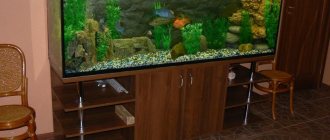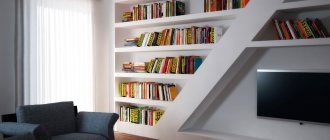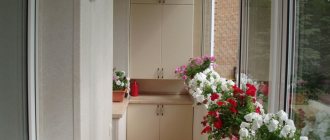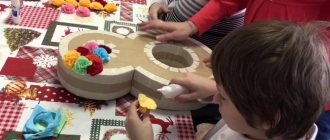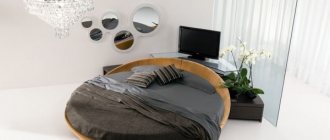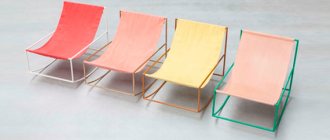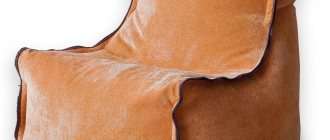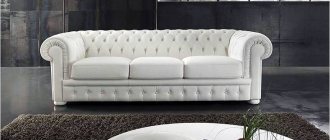Implementation aspects in special cases
Drywall has long had one drawback - it was not recommended to use it in places of high humidity, first in bathrooms.
But technologies are developing and you can increasingly see so-called water-resistant drywall on the market. This can also be used with success in bathrooms. The thickness of this material is still 12.5 mm, but the cost is certainly higher. Partitions created from plasterboard are completely reliable structures, but they should not, however, be tested for impact and moisture resistance. (see also the article How to make plasterboard shelves: sequence of work and useful tips)
Treat your own creation with great respect. First, calculate everything exactly. Watch the video on our website. Get to work with a cool head and plenty of time to spare.
From time to time, check the reliability of what you are creating. And you can be sure that the partition will serve you for many years.
Until you want to change its design - and this is also their huge advantage. Just as quickly they can be built, they can just as quickly be dismantled. And all this - to configure the design of the room.
Share this entry
- Installation of heating system by yourself. November 14, 2014 — 10:54 am
- Decorating a living room in English. April 2, 2014 — 11:20 am
- Interior design styles November 4, 2015 — 10:48 am
- Restoring bathtub enamel. How. September 20, 2014 — 6:10 am
- Wallpapering or stretch ceiling. September 20, 2014 — 1:39 am
- Ways to save money during repairs September 20, 2014 — 12:51 am
- The slopes of the front door are their own. September 18, 2014 — 2:39 pm
- Multi-level ceiling with your own. September 18, 2014 — 2:39 pm
- How to install a dishwasher. September 18, 2014 — 2:39 pm
- How to change the front door September 18, 2014 - 11:07 am
- How to paint a ceiling September 18, 2014 — 11:07 am
- Where to start renovating a kitchen March 28, 2014 - 4:52 am
- Which bath to choose April 2, 2014 — 11:15 am
- How to choose bathroom tiles April 2, 2014 — 11:08 am
- Small kitchen design April 2, 2014 — 10:57 am
- Interior of a small kitchen April 2, 2014 - 10:39 am
- Sequence of plumbing. April 2, 2014 — 10:33 am
- We lay the tiles on the wall. April 2, 2014 — 10:29 am
- 10 mistakes you shouldn't make. April 2, 2014 — 7:22 am
- How to whitewash a ceiling correctly. April 2, 2014 — 4:10 am
- Interior design styles November 4, 2015 — 10:48 am
- Decorating a Khrushchev-era kitchen November 3, 2015 — 6:22 pm
- Renovation design of a small kitchen November 3, 2015 - 8:08 am
- Bedroom design 20 sq m November 3, 2015 - 3:27 am
- Decorating a bathhouse with your own hands November 2, 2015 — 1:36 pm
- Design your own garden house. November 2, 2015 — 4:08 am
- Kitchen design 7 sq m November 1, 2015 - 6:22 pm
- Design of a two-room apartment. November 1, 2015 — 10:27 am
- Ceiling design in the living room October 31, 2015 - 2:44 pm
- How to hang wallpaper on whitewash October 28, 2015 — 4:19 pm
- Wooden interior design. October 28, 2015 — 5:33 am
- Repairing the ceiling in the bathroom. October 28, 2015 — 3:00 am
- Adhesive for vinyl wallpaper October 27, 2015 — 3:21 pm
- Modern room design for. October 27, 2015 — 6:32 am
- Repair of chipboard furniture October 26, 2015 — 1:56 pm
- Plastering on polystyrene foam October 26, 2015 — 4:24 am
- Design of a narrow room October 25, 2015 — 11:46 am
- Kitchen living room interior October 25, 2015 - 7:41 am
- Do-it-yourself wall repair October 25, 2015 — 2:07 am
- Living room design in Khrushchev October 24, 2015 - 7:32 pm
Necessary materials and tools for installing plasterboard walls
To install a plasterboard wall with your own hands correctly, you need to prepare the following tools and additional consumables:
- Special handles that will help you quickly, efficiently and without compromising the integrity of the sheet to be transferred to the installation site. But it is advisable to use them only when the construction is carried out professionally or when the volume of work performed is large enough.
- A mounting support in the form of a lever on a stand is capable of holding the material in the desired position while covering walls or forming niches and partitions. It is this that will maintain the vertical position of the structure while the sheet is attached to the profile.
- If you need to assemble a complex wall or install a ceiling structure, it is recommended to use a frame lift.
- If it is impossible to buy such an expensive structure, you can use ordinary T-shaped supports, at least 2 pieces. Their main advantage is that they help to attach the sheet and secure it in the desired position at the time of fixation.
- Measuring tools such as a tape measure and a level will allow you to lay the sheets exactly horizontally and vertically, without distortions.
- A square is necessary for marking corners and maintaining their perpendicularity.
- To cut sheets, you will need a special knife and a special narrow cutter for cutting strips no more than 12 cm wide.
- Hand hacksaw.
To install a plasterboard wall with your own hands correctly, you need to prepare special tools.
Flow calculation
To accurately calculate the amount and size of drywall for walls, you first need to know the exact area of the shelter. If the wall is not a rectangle, then you can immediately round the value to it. Then you need to divide this number by 3 sq.m. to get the number of sheets that will need to be purchased for installation. It is also important to take into account the required margin, which should be increased by about 10-15% from the calculated number.
To accurately calculate the amount and size of drywall for walls, you first need to know the exact area of the shelter.
Nuances of the work
We will analyze three design options:
Each option has its own characteristics, but there are also general criteria that we will consider first:
You need to know the sizes of the sheets used. The most common options on sale are 1200x2500 mm and 1200x3000 mm. The area of the first type of sheets is 3 square meters, and the second - 3.6 square meters. The specific height is selected for the object, taking into account that a minimum amount of waste remains during work;
The weight of one sheet also changes depending on the size.
- Sheet thickness. 9 mm thick options are most often used for ceilings, while 12 mm is the best choice for walls. The other types presented in the table above are rare, so I advise you to choose one of the two listed types of material;
- Number of layers. Most often, the sheets are attached in one layer, but if additional strength and resistance to cracking is needed, then a two-layer finish is used. In this case, the calculation result must be multiplied by two.
With a two-layer fastening, the consumption of drywall per 1 m2 doubles, and the sheets are fastened with an offset
Ceiling structures
The calculation of a plasterboard ceiling is made taking into account the following aspects:
Illustration Description
A diagram of the arrangement of sheets is made. The ceiling is drawn and the location of the profile and the direction of fastening the sheets are marked.
It is important to choose an option so that you get a minimum amount of waste when working.
You can calculate the material for a single-level ceiling without a drawing. To do this, you need to measure the length and width of the room and calculate its area. Next, indices are used for accurate calculation: For an area of less than 10 square meters
the result is multiplied by a factor of 1.3; For an area of 10 to 20 squares, an indicator of 1.2 is used; For an area over 20 sq.m. the index 1.1 is used. The finished result is rounded up according to the number of whole sheets.
For multi-level structures, the calculation procedure is different: First of all, you need to calculate the area of each of the levels and the dimensions of the end sections, if any; All results are summed up, and the final result is multiplied by the index 1.2, since waste is inevitably generated during the work process; If the structure has a complex configuration and irregular shape, then the index will be even higher. You need to calculate consumption individually.
Most often, 9 mm thick sheets are used for ceilings; they are much lighter. But if desired, you can also use 12 mm options, but remember that the load on the structure will be much higher.
Wall cladding
If you need to fix drywall to the walls, then the gypsum board calculation will be carried out in this order:
| Illustration | Description |
| Sketches of the walls are made. This is necessary so that you can see the width and height of the structure and can mark the location of the openings in order to take into account their sizes and not purchase excess material. If you are calculating the material for a room, then you need to draw a projection of each of the walls. | |
| Determine the layout of the sheets. It is most convenient to place them vertically on walls. You decide which side to start installation from; it all depends on the presence of openings and the convenience of covering them; try to minimize the amount of waste. | |
| Don't forget to take into account slopes. Usually this part of the structure is also sheathed with plasterboard, so you need to measure the width and height of each side. If you have deployed structures, then this point should also be taken into account when calculating. |
Partitions
If you decide to build a plasterboard partition with your own hands, then the instructions for carrying out the work will look like this:
Illustration Description
A design sketch is made
At this stage, it is important to plan the location of the metal profile racks and determine the size and exact position of the opening or openings. Also decide on the arrangement of the sheets; it is best if the surface from top to bottom is covered by one element.
The exact amount of material is calculated. The result is multiplied by two and a small margin of 10% is added
If you have doors placed in the openings (as in the photo), then they do not need to be sheathed, but if there are just arches, then drywall is also attached to them. Regular or moisture-resistant drywall is used, the price of the second is higher, but it is suitable for wet rooms.
Frame diagram
It is impossible to correctly build a partition without creating a drawing. It will be required already at the stage of purchasing material. Yes, and it is impossible to mentally calculate all the subtleties of placing profiles and fastening gypsum boards. The drawing will help you use the material more rationally and avoid unwanted losses.
The dimensions of the future partition are determined as follows:
- The required size of the separated room or section of the room is laid out on each wall. This is done twice: at floor and ceiling level.
- The resulting lines are connected vertically, their location is controlled by a plumb line.
This algorithm is needed due to the fact that in apartments the floors are rarely even and located at right angles.
- The verticals on the walls are connected by lines on the ceiling and floor surface, resulting in the outline of the future wall.
The drawing is transferred to paper, the location of the rack profiles and partitions, as well as the doorway, is outlined. The following rules are observed:
- Vertical posts are located in increments of 400 or 600 mm. This will allow you to avoid unnecessary cutting of plasterboard sheets: they will be joined on the profiles.
To impart rigidity to the structure, the sheets on both sides must be connected on different racks. For example, on the front - on odd profiles, on the back - on even profiles.
- The space above the door is further strengthened by at least a pair of guides.
- At the same stage, the mounting locations for all additional accessories, such as a TV, are determined. These areas are also strengthening.
- The number of required horizontal jumpers is calculated. GCRs are joined to them if the partition is longer than their length. But even when the sheet completely covers the opening in height, it is recommended to fasten a couple of horizontal profiles to provide rigidity.
USEFUL INFORMATION: Wall decoration ideas: decorating an apartment with your own hands
And one more important point. If a sliding door is installed in the partition, the doors of which, when opened, will drive into the plasterboard wall, the profiles should be arranged in 2 rows, as in the photo.
Note! In such a design, there should be no jumpers, wires or any other communications or obstacles along the direction of movement of the door leaves.
The next photo shows a simpler solution. A standard wall with an opening is made, and the sliding door is located outside, on one side.
The frame for the partition with niches shown in the next photo has a more complex design. Making niches yourself is described in detail in this article.
Based on the drawing, the required amount of material is calculated. After purchasing it, you can begin installing the frame.
Optimal thickness of plasterboard partitions
The thickness of the gypsum board for the interior partition depends on the purpose of the wall. If this is a decorative false wall, the minimum sheet thickness will be 12.5 mm. If you are planning a full-fledged partition, in which it is possible to install shelves for books or various souvenirs, then some calculations will be required:
- If the load is 40÷50 kg/m², you need a sheet with a thickness of at least 15 mm;
- Load 50÷70 kg/m² – about 18 mm;
- Over 70 kg/m² involves the use of double sheets and reinforcement of the frame structure.
When sheathing the frame, you should not make joints between plasterboard sheets of opposite walls at the same level. This will lead to weakening of the structure and the appearance of cracks at the seams
But the choice of gypsum boards is not the most important thing in such an installation. Before you make a plasterboard partition in a room, you should understand which metal profile to choose for certain purposes
With such a frame, jumpers are not required - the wall will be strong
Main types of partitions: features and markings
| Image | Construction type | Options | Some characteristics |
| S111 | The weight of 1 m³ is 28 kg, the recommended height is up to 8 m | A single frame made of galvanized steel profile, which is sheathed on both sides with sheets of waterproof plasterboard in one layer. The inside is filled with sound insulator in the form of mineral wool. Used as partitions in rooms with low requirements for sound insulation and fire resistance. The thickness of the partition depends on the size of the profile and gypsum board. | |
| S112 | Weight 1 m³ – 53 kg, height 4÷9 m | Single metal frame with two-layer gypsum board sheathing on both sides. Filler – mineral wool. The design provides high sound insulation characteristics and fire resistance (up to 1.25 hours). It is used for redevelopment or capital construction. | |
| S113 | Height up to 9.5 m. Weight 1m³ – 78 kg | The single frame is sheathed on both sides with sheets of waterproof plasterboard in three layers. By increasing the number of gypsum plasterboard layers, sound insulation increases. | |
| S115.1 | Height – 6.5 m, weight 1 m³ – 57 kg | Double frame covered with gypsum board in two layers. Along with strength, it has excellent fire resistance. | |
| S115.2 | Weight 1 m³ – 69 kg. Height up to 9 m | In addition to the two-layer sheathing, the double frame is separated by an additional sheet of plasterboard (spaced frame). Due to this, strength and thermal insulation properties increase. Mineral wool slabs are laid inside. | |
| S116 | Height 4.5 – 6.5 m, weight 1 m³ – 61 kg. Minimum partition thickness 220 mm | A double metal frame covered with two layers of plasterboard is convenient for hiding communications. Fire resistance - 1.25 hours. Sound insulation up to 50 dB. | |
| S118 | Weight 1 m³ - 86 kg. Height up to 9 m | Partition class “Protection of premises from penetration”. Made according to type C113 with a single metal frame covered with a three-layer plasterboard covering. A special feature of the product is galvanized steel sheets, 0.5 mm thick, inserted between the gypsum boards, which significantly increases the strength and fire resistance of the structure. Most optimal for creating a plasterboard partition with a door in a warehouse. | |
| S121 | Weight 1 m³ – 32 kg. Height up to 3.1 m | The frame is made of wooden beams with a moisture content of 12% and sheathed on both sides with one layer of plasterboard. | |
| S122 | Weight of 1 m³ – about 57 kg. Height up to 3.1 m | Two-layer “upholstery” of the gypsum board wooden frame. The insulating material of the partition is mineral fiber boards. Advantages: high strength and good sound insulation. |
But here they are already necessary - the distance between the racks is large
Related article:
Preparing the walls for finishing
Having coped with the task of how to make a plasterboard partition in a room, you can think about decorating it - painting or wallpapering. But for this you need to do some preparatory work:
- First, holes are cut in the casing for the output of communications, installation of sockets and switches.
- Then the depressions from the heads of the screws and all the joints between the plates are puttied, while simultaneously gluing them with reinforcing tape.
Puttying seams between gypsum board sheets Source prorab.help
- After the putty has dried, the surface is sanded, dust is removed and coated with a primer.
- The final stage is to putty the entire surface with a thin-layer non-shrink mixture.
On a note! If you stick wallpaper directly onto drywall without a putty layer, it will be difficult to remove it during repairs without damaging the cardboard shell of the sheets.
What to buy, how to calculate?
First, you need to decide on the size of the required partition. Having determined the number of sheets on one side, do not forget that the same volume of sheets will be required to sew the second side of the partition. Materials you will also need:
- Guide profiles, size 50x40. You need enough profile to cover the entire perimeter of the partition.
- Rack profiles 50x50. They differ from guides by having shelves at the top and bottom. The calculation is carried out individually, based on what type of installation will be used by the master.
- Dowels and screws, 45 mm long - for fixing guide profiles to the floor, walls and ceiling
- Metal screws 35mm - for fixing drywall to the frame;
- Self-tapping screws with a 10 mm press washer for attaching profiles to each other;
- Perforated paper and gypsum putty.
In addition to the material, you need to ensure the availability of construction tools. If you don’t have one at home, so as not to spend money on buying it, you can rent the equipment. A hammer drill, a drill, a plumb bob, a level, and a screwdriver will be useful for installation.
Frame assembly
At the first stage, we construct a frame from guide profiles:
- Using metal scissors, we adjust the elements to length.
- Usually they already have holes placed at the required pitch. If there are none, then we need to drill holes for fasteners every 50–60 mm.
- We glue a sealing damper tape to the back side of the profile.
- We place the profiles in place and mark the holes for the dowels. You need to make sure that all the guides are on the same side of the marking line.
- Using a hammer drill, we form holes and drive in plastic dowels. Then we fasten the profiles by hammering in the dowel-nails with careful blows of a hammer.
In the case of wooden walls and ceilings, the procedure is simplified: dowel-nails are replaced with wood screws with a wide head.
Attaching racks and horizontal jumpers is easy:
- We cut the vertical elements so that they are 8–10 mm less than the height of the room.
- After installation in the guides, we fasten them using small screws or a cutter.
Using a cutter has an important advantage: the joint is completely smooth. The caps of the screws will prevent the drywall sheets from fitting tightly to the frame.
- We control the vertical installation of each guide using a level.
USEFUL INFORMATION: How to properly make a doorway in a brick wall?
- We cut horizontal jumpers into elements whose length exceeds the distance between the posts by 100–200 mm. At the ends we remove the side walls, forming a flat “tongue”. Then we fasten them with self-tapping screws to the racks.
A more reliable, but also more labor-intensive method of forming horizontal jumpers: having cut through the side walls, we bend the excess on the profile at a right angle. Then we place the resulting “ears” on top of the vertical posts and fix them. This is usually done when forming a doorway.
- The opening under the door must be strengthened. This can be done by twisting two profiles together or placing a wooden beam inside the metal elements.
The process of creating jumpers and assembling the frame using a cutter is presented in more detail in the following video.
Partition marking
To mark the partition, we take into account that its thickness will be:
- 50 mm profile frame;
- 4 sheets of plasterboard 12.5 mm each, 4 × 12.5 mm = 50 mm.
Total 100 mm.
Marking the partition.
The first marking line is applied to the stream
To apply markings we use a marking cord; From the top line along a plumb line (thread with a load), the line of the partition on the floor is measured; Taking into account the thickness of the partition and its alignment, the PN 50/27 profile is attached to the ceiling and floor; A sealing tape is glued to the profile shelf from the outside; it is “self-adhesive”. The tape will seal the connection and improve the sound insulation of the partition;
- To fasten the profile, dowel “K” 6/35 is used. The fastening step is 60 cm, the first fastening is 25 cm from the wall;
- To drill concrete you will need a hammer drill. If the partition is installed on a wooden floor, replace the “K” dowel with TN35 self-tapping screws.
It is important to maintain the exact location of the lower profile under the upper one. We fasten vertical posts every 600 mm
For this:
We fasten the vertical posts every 600 mm. For this:
- Measure the distance from the top to the bottom profile;
- Using metal scissors, cut the stand to size;
- The first outermost post of the partition is attached close to the wall. Next, the remaining racks are attached in increments of 600 mm. The last rack is also attached close to the wall;
- We fix the rack profiles in the guide profiles, strictly vertically, with a divider or 19 mm metal-to-metal screws (they are not in the list). We fasten the profile in 8 places, two on each side.
How to assemble the frame correctly
- First, you need to install and secure along the bottom guide with dowel nails, not forgetting that the doorway remains empty.
- Rack profiles are attached to concrete walls in the same way. For wooden walls, dowels are not needed. Self-tapping screws are screwed through guides directly into the walls with a pitch of 25x30 cm from each other.
- The guides and rack profiles are connected using self-tapping screws with a press washer or a riveter.
- Wooden blocks are inserted into the profile around the doorway and secured with self-tapping screws. Or an additional reinforced metal profile is installed.
- The distance from the wall to the door is measured, the number of profile posts is calculated, taking into account the step between them of 30, 40 or 60 cm.
- The required number of blanks is prepared according to the required dimensions. The frame posts are placed with their ends inside the upper and lower guides. Before fixing the profiles with self-tapping screws or rivets, they are leveled.
- With a high ceiling, the frame is strengthened by horizontal jumpers between the rack profiles.
After the manufacture of the frame for the partition is completed, electrical wiring is installed inside it, if provided. This can be done after covering one of the sides, or before that. The wires are packaged in corrugated tubes.
Covering the upper part of a door or window opening can be done in this way: mark the required length on the profile, adding 150 mm on each side. These will be kind of guides. From the sides of the profile, we measure 45° angles according to the marks and cut along the cut line. Then we bend the outer parts towards the profiles to form a U-shaped structure. We put this blank with bent “ears” onto the racks, then raise it to the required height and fix it with self-tapping screws.
Ways to strengthen the frame
To strengthen the door frame, wooden blocks are placed inside the PS profile (with its front side facing the inside of the opening) or, as mentioned above, a UA profile is installed. The cross-section of the bars is selected according to the size of the profile to be strengthened.
To strengthen the structure of the partition, they resort to the following techniques: reduce the pitch between the racks (up to 400 mm), use wooden embedded bars (to strengthen the rack profile), and use a paired PS profile.
An additional profile installed inside or next to the rack also strengthens the partition structure. In places where attachments are attached, the frame is reinforced with embedded elements in the form of wooden blocks or pieces of plywood 2-3 cm thick, which are secured between the posts using crabs or half-crabs.
Frame installation
Installation of guide profile (PN)
1. Installation of the frame begins with the installation of the PN guide profile along the perimeter of the marking. Between the profile and the wall, according to the rules for installing partitions, Dichtungsband sealing tape is glued. The tape is glued to the outside of the profile shelf.
2. PN profile to the base. screwed with self-tapping screws if the base is wooden or a dowel with nails (Dowel K) if the base is concrete. For a brick base, use a plastic dowel and a screw with a length of 50 mm.
3. At the location where the door is installed, a special bend of the profile is made, which will be used to connect it to the post profile (see photo).
Installation of rack profile
1. The rack profile should be 1 cm less than the actual height of the room. In this case, it should “cling” to the guide profile with 2 centimeters of its length. The rack profile is first inserted into the lower guide profile, and then inserted into the profile on the ceiling.
2. The pitch between the centers of the rack profile is 600 mm. Rack profiles are mounted from the wall to the doors. With a short partition, the distance between the profiles can be reduced to 300 or 400 mm. The main thing to remember is this step, so that with a two-layer sheathing, you can get the screw that secures the second sheet into the profile of the rack.
3. Let me remind you that the doorway must have two posts installed on each side of the opening. One rack with a beam for the door frame, the second rack is a rack profile included in the partition frame.
4. Frame profiles are connected to each other with a special tool, a cutter or LN 19 mm self-tapping screws.
Please note that all rack profiles must be aligned strictly vertically.
Video description
This video shows other, more reliable ways to extend racks:
Note! In the frame, the joints should be placed not on the same line, but staggered.
The first to be installed are the racks that limit the doorway. They will bear increased load, so they must be rigid. Before you make a plasterboard partition with your own hands, you need to think through this issue. You can ensure rigidity in different ways:
- use a profile with large wall thickness (up to 2 mm);
- make racks from two profiles folded into a box;
- place a wooden beam of suitable cross-section in the profile.
The upper horizontal lintel of the doorway is also cut from the rack profile and attached level to the side ones.
Installation of rack profile (PS)
The racks are made from PS profile
length 3000 or 4000 mm. Thanks to the ribbed surface and curved edges, it has greater bending rigidity. Its width in the partition design depends on the height of the room being repaired, the weight of wall objects and gypsum plasterboard slabs.
In kitchens, corridors and hallways (in areas with high traffic), a stronger profile with a width of 75 or 100 mm is installed. A pair of such racks (PS-100) can support a door weighing up to 30 kg. When installing more massive structures, use the UA profile - a reinforced version of the rack profile with a thicker wall. When installing a UA profile, the maximum permissible weight of the door leaf increases to 70 kg.
Vertical posts are fixed along the edges of the guide profile. They are cut so that a damping gap of 10 mm is formed between the tops of the supports and the ceiling profile, designed for shrinkage of the building.
Be prepared for the fact that the profile may bend at the cut points. If the support posts are deformed, take pliers in your hands and straighten their edges.
After cutting, each of the racks is attached to the lower profile, and then, like a support on a hinge, its free end is tucked into the upper guide, aligned vertically and screwed to the PN profile using self-tapping screws.
The row posts and posts that form the base of the doorway are installed in the same way. The difference in their installation is as follows: the first, as a rule, follow a standard step of 400 or 600 mm (since the width of the plasterboard sheet is 1200 mm), and the second are installed directly on site and are tied to the width of the doorway.
Marking the axes of ordinary racks begins from the edge of the wall. From it to the center of the first rack (when aligning and installing them, the tail of the tape measure can be hooked onto the edge of the guide profile) and the central axes of other supports are set aside 600 mm. When the bevel of the outer sheet is cut, the distance to the first rack is reduced to 550 mm.
In case of increased load on the frame (when tiling a wall, hanging heavy cabinets, boilers, heating radiators on it), the distance between the racks is reduced to 400 mm, remaining a multiple of 1200 mm.
With the above steps of the frame racks, the plasterboard sheets are joined in the middle of the profile.
How to make a partition from a profile?
Drywall is a universal and most common material for creating partitions in rooms. Partitions can be made both in a decorative design and in a classic, flat form. Regardless of the type of partition, the frame requires a special metal profile.
We recommend: Sand-lime brick (43 photos): characteristics, composition, pros and cons
To install the partition, first, attach a guide profile . then frame profiles are installed into it. The profiles are joined together using small screws with a drill at the end.
Device design
From plasterboard, using various types of frame elements and fastening systems, you can easily assemble any device. Most often, plasterboard is used to level walls, install ceiling structures, and also assemble partitions. Let's consider what we need when forming the frame for the partition. A similar structure can be constructed using the following elements:
- profile guides. They will act as load-bearing elements;
- rack profiles. They are used to enhance the strength and rigidity of the structure being built. In addition, niches or shelves are formed from them.
Such elements are needed if the design is simple and does not contain complex shaped components. Very often, partitions are used to delimit space into certain zones. They are often made as decorative elements of the interior. To create them, it is necessary to use arched flexible metal profiles that can form the desired shape. As you can see, the wide variety of building materials market can cause confusion when purchasing frame elements for further covering with plasterboard sheets. Therefore, before going to the store, be sure to decide what you need. This will significantly save you time, money and make your installation work easier.
How the marking is done
Profile marking for drywall
- It is best to mark sheets on the floor. For this you will need:
- pencil;
- construction corner;
- long ruler (you can use a rule or a long building level).
With their help, it is possible to perfectly correctly mark straight lines and draw them. The lines are intended to fix the places for attaching the guides from the profile.
- The line should also indicate the place where the doorway will be located. There shouldn't be a guide there.
- A straight line is projected from ceiling to floor. A plumb line is used.
- At right angles from the edges of those lines on the floor, vertical straight lines are drawn along the walls to the ceiling. This marks the beginning and end of the horizontal projection line.
- Having marked the points on the ceiling, taking them into account, draw an exactly straight horizontal line. This is where the guide is secured.
It is very important to measure these two lines extremely correctly. The verticality of the wall being built will mainly depend on these marks.
Frame installation process
Step one. Guide profiles are installed. First, the profile is secured to the floor using dowels. You only need to leave untouched the place where the door opening will be installed. Holes for dowels are drilled through the laid guides. After this they are removed. Plastic plugs are driven into the holes. Now the guide should be put in place, secured with driven dowels (you can use self-tapping screws).
Installation of vertical rack profiles
Step two. Guides are installed on the walls taking into account the previously marked vertical lines. Their position is constantly checked by level. Then there will not be even a slight play to the side.
Step three. The lower part of the vertical profile is inserted into the horizontal guide, which is located on the floor. The process of attaching to concrete walls is carried out in the same way as on the floor. And for wooden walls, dowels are not needed. Screws are screwed through the guides directly into the wall.
Step four. Attach the guide to the ceiling. This should be done in the same way as on the floor. Screw in the screws from each other at a distance of 25-30 cm. Connect the horizontal profile on the ceiling with the vertical one in the same way as on the floor. That is, they use self-tapping screws (you can use rivets).
Step five. You will need to mark on the ceiling profile the place where the doorway will be located. In this case, the lower markings are taken into account and a plumb line is used.
The height is measured to prepare the guides. They will be installed on the sides of the door opening. You will need to measure the required length of the starting profiles, and cut out the blanks. Next, they are installed in such a way that they mark the doorway.
The racks are installed in guides on the corner profiles on the ceiling and floor
Step six. The guides that are installed around the door opening are strengthened. Wooden blocks are used. These parts are inserted directly into the guides, secured with self-tapping screws.
For your information. Sometimes it is worth attaching an additional reinforcing profile to the first profile to increase the durability of the structure.
Step seven. As soon as the vertical profiles are installed and strengthened, the height of the opening is marked on them. Taking these marks into account, screw a horizontal crossbar from a section of profile of a suitable size. After this, a wooden beam should also be inserted into it, and vertical posts should be screwed to it. Long screws are screwed into the end of the crossbar, which was mounted horizontally.
Step eight. Measure the space between the walls and the doorway. Calculate how many vertical posts are required. They are attached to each other approximately at a distance of 30-60 cm.
You will need to cut the workpieces in the required quantity to the required length. The racks are installed, their ends are directed inside the guides located on the ceiling and floor. Again, a level is used to level their position. Using self-tapping screws, the profiles are fastened at the joints. Here you will need screws with large heads. You can use rivets.
On a note. To ensure greater rigidity, horizontal crossbars should be installed between the vertical posts. This is especially true when working in a room with a high ceiling.
Frame components
In most cases, the material for making profiles is steel strip. The thickness of such tape is less than 1 mm. In terms of external characteristics, it looks like a long metal strip.
The steel strips that are commonly used to produce these parts have numerous advantages. That is why their popularity among consumers is so high.
Such profiles enhance the level of rigidity of the structure without unnecessary weight.
The modern market offer includes several varieties of similar materials, plus additional elements.
To erect a structure from gypsum plasterboard you will need:
- rack profiles;
- jumpers;
- guides (aka main ones).
Frame elements parameters
The above information is very important. But here there is another equally important “pitfall” on which you can not only stumble, but also drown. And this “stone” is the thickness of the frame element. Note! Buy metal profiles only of the required thickness. This parameter is determined by the required strength and rigidity of the structure. For purely decorative designs, you can use not very thick elements. But massive structures, such as a closet, partitions with many niches, require the use of elements with greater thickness. Modern metal profiles come in three main types by thickness:
- thickness 0.4 mm. It is considered the “weakest”, so it is not used when assembling large-scale and large-sized plasterboard structures. When attaching such elements, the screws in them very often simply turn;
- thickness 0.45 mm. It is considered the “golden mean”. It can already be used for lathing walls, ceilings and further installation of drywall on it;
- thickness from 0.55 mm. The most expensive and “serious profile. It is used for installing complex wall devices, as well as for assembling structures that are subject to heavy loads.
The thickness of the metal profile should be selected based on what you plan to make from plasterboard: an arch, partitions, niches, ceiling structures, or simply sheathing walls.
Installation of rack profiles
When installing rack profiles, screw the fasteners first into the back of the profile and then along the groove. This will avoid deformation of the frame after installation.
Characteristics of guide parts
The main part of the frame (PM) has a U-shape.
Center frame elements
This part is available in four standard sizes:
The first indicator indicates the width of the shelf, the second reflects the size of the width of the backrest. If you plan to install a decorative partition with shelves, choose a product with a wide back.
We recommend: Connecting a generator to the network of a country house - diagrams and all methods
The back of the guide profile is equipped with holes for dowels. The diameter of the holes is 0.8 cm.
In some cases, parts of this type are marked UW. Selecting material to make a plasterboard partition. Please note that elements marked UW-50 correspond to parts marked PN (4x5 cm).
From the name it becomes clear that such profiles are used as guides. At the same time, they are attached to the floor and ceiling according to the markings. In turn, the rack profiles are fixed to the main strips.
How to cut sheets and attach them to a frame
Covering the frame with plasterboard
The wiring has already been done. Then you can begin attaching drywall to any side of the frame. To screw it on, black self-tapping screws are used. They are specially produced for this purpose. The heads of the fasteners should be slightly deepened into the gypsum board - a maximum of 1 mm.
Some locations will only require certain sections of material for installation. Drywall is cut in this way.
First stage. Measurements are taken of the area on the frame that needs to be covered.
Second phase. All measurements are transferred to the sheet. Using a ruler and pencil, make marks.
Third stage. Drywall is cut. To do this, you will need to have a knife that is used to cut paper, or a special one for drywall. You will also need a hand saw with a fine-toothed blade.
Fourth stage. When a cut is made with a knife, the blade is guided strictly along the established ruler. Only cut through the top layer of drywall and go slightly deeper into the plaster. The bottom cardboard should remain intact. The sheet is folded along the intended line and passed with a knife along the fold, cutting the material to the end.
Fastening plasterboard sheets, joints
Fifth stage. The partition usually contains sockets and switches. Then, after pulling the wiring, holes of the required diameter are drilled in the drywall using “crowns”. After completing the installation of the partition, wires will be routed to these places and electrical devices will be connected.
First, drywall is installed on one side of the frame. After this, insulation is placed between the guides on the open side. Commonly used:
- mineral wool;
- isover;
- expanded polystyrene.
Now it's time to sew up the second side of the frame. Drywall is installed in the same way as on the first side.
Frame installation
After marking, installation begins. They move from the floor up to the ceiling. After applying the markings to the floor using a plumb line, it is transferred to the ceiling to prevent the structure from tilting. Here's how to make a drywall frame from a profile:
- Installation of the guide profile. Using screws, the UW is installed around the perimeter. When installing a structure in which there will be a door, a guide is not applied to the opening area. The distance between the fasteners is 40-60 cm; the larger the opening, the wider the screws can be installed.
- Installation of rack profile. Measure the length of the metal element 0.5 cm less than the distance from the ceiling to the floor. Place the parts into the guides and adjust them to the marks on the floor and ceiling that correspond to each other. The distance between the racks is equal to the wide part of the gypsum board.
- Processing the opening. If a door is supposed to be in the partition, then additional racks are placed along the edges of the box. They need to be turned with their backs towards the inside of the frame, since a box or arched casing will be attached to them. A guide profile is placed above the opening, which is connected to the ceiling by racks. The substation is located in the area where the gypsum boards will be connected.
Frame installation
The assembly of the frame is completed, now we can begin covering it using plasterboard sheets. It is possible to facilitate the installation of the structure if the height of the sheets is cut so that they are 1 cm less than the absolute size. When installing gypsum boards, place 0.5 cm pads on top and bottom, and remove them immediately after installing the sheet. This creates expansion gaps that help the linear expansion of the material.
Electrical wiring installation
Wiring in the gypsum board profile
After the installation of the frame is completed, electrical wiring is installed inside the structure. This is done if it is provided for in the scheme.
It is easiest to install the wiring when the plasterboard sheets are secured to one side of the frame. But you can do this work initially, while the sheets have not yet been installed.
Holes are drilled in the profiles for pulling wires. They are placed in insulating tubes:
- smooth;
- corrugated.
The ends of the wires are brought out.
Methods for creating jumpers
It will not be possible to build a frame without jumpers. These elements are also made by hand.
Jumper manufacturing options:
- The edges of the guide element are cut at an angle of 45 degrees. The edges are folded along the cuts made. The resulting product has one important advantage - it fits on any side of the profile. There is also a drawback to a jumper of this shape. It has a low level of strength.
- Another method of making a lintel with your own hands also requires making V-shaped cuts on the profile. After which the product is bent inward. In this case, the edges are fixed to each other. Fastening with such a jumper is reliable and strong. However, this product can only be used on elements that are part of the assembled box.
- Sometimes the two previous methods are combined. To do this, an incision is made from one edge of the profile, as in the first case, and from the other edge, as in the second. The advantage of this product lies in its universal use, regardless of how the parts are located in relation to each other.
Jumper manufacturing diagram
- There is an option for assembling a jumper from sections of rack and guide profiles. To do this, a couple of pieces are cut from the second (the main frame material). The length of these segments is 10 cm. Next, they are inserted into a jumper made of a rack element. The main advantage of this method lies in the rational use of leftover material. In addition, the result is a reliable frame structure. There is only one drawback - cost. As a result of construction, there is more than enough scraps from the guides. But the rack profiles will have to be specially cut for these purposes.
Selecting sheet thickness
Of course, the main thickness of the false wall is determined by the profile, but gypsum board, which is available in three sizes, also makes its contribution.
Thickness can be:
- 12.5 mm is the most suitable type (and thickness) for creating partitions;
- 9.5 mm – used for suspended ceilings;
- 6.5 mm – the thinnest type (arched). It turns out to be indispensable when installing on a curved frame made of metal profiles; it bends much easier.
Plasterboard structures allow you to perfectly divide the space of a room, but in no case should you forget about planning a passage or doorway
Total septum thickness indicators
Thus, the total thickness of the plasterboard partitions is determined by the thickness of the profile used and the thickness of the sheet.
The following are the most widely used options for partitions in terms of thickness (without taking into account minor errors in fastening and finishing, which can give an increase of 2-4 mm):
125 mm – PS profile 100 mm + 2 sheets on both sides. This thickness fully meets the long-term standards for the performance of internal walls made in a major way during panel construction.
73 mm – arched PP profile 65 mm + 2 sheets of the thinnest plasterboard on both sides. The thinnest partition that can be obtained in a combination of plasterboard-profile-plasterboard. Such a false wall of minimal thickness is only decorative; you should not place any hopes on it in terms of load. (see also the article Profile for plasterboard partitions: the basis of the false wall frame)
Alternative options for increasing rigidity
The two sizes given are limiting in terms of rigidity - maximum and minimum. But design goals sometimes force us to create a variety of combinations. On the widest PS profile you can apply a layer of the thinnest drywall by combining several layers at once. In this case, however, you will have to stock up on a fair amount of additional screws.
As installation proceeds, the room is transformed literally before our eyes, but a preliminary calculation of the ratio of the width of the drywall sheets and the location of the profiles is necessary
A standard sheet measuring 2.5 x 1.2 m requires about 60 screws. If you decide to lay 2 layers one on top, the first layer will require no more than 6-8 screws 2.5 cm long. They must be placed in increments of 1 m. But the second layer will require 4 times more fasteners 3.5 cm long. 5 cm, while the installation step should be 25 cm.
Helpful advice! When installing sheets on a metal frame on both sides, follow the long-standing construction rule of staggered placement. Shift the sheets on the reverse side exactly half the width. This simple technique allows you to significantly increase the rigidity of the entire structure.
If the thickness of the partition significantly exceeds the thickness of the structure (the profile is two plasterboard sheets), special care will have to be taken about the end of the false wall
Good design requires maximum use of all available space. By creating a wider false wall, you can provide yourself with additional space at the end. In this situation, you will have to take care of increasing the reliability of the frame by introducing additional horizontal cross members into the structure. (See also the article How to make a niche from plasterboard: tips and tricks)
Not a single instruction will teach you how to do this; imagination and design ideas reign here, and the source material is still the same - 4 types of aluminum metal profiles, fasteners and photos of possible implementation options.
Let's not forget about the possibility of a wooden frame - in some cases it may seem more convenient than a metal profile frame
Features of plasterboard walls
Before finishing or erecting plasterboard walls, it is important to understand the characteristics of this finishing material. The gypsum and cardboard that make up the material have unique technical and physical properties. The main thing is the ability to breathe and absorb excess moisture. If the air around is too dry, then this excess moisture will be removed, on the contrary, into the surrounding space from the finishing material.
Another point you need to know is the environmental friendliness of drywall.
The gypsum and cardboard that make up the material have unique technical and physical properties.
Their device
Such sheets are a combination of two main materials - gypsum and cardboard. The cardboard in the composition serves as the side planes, while the gypsum inner filling with reinforcing components creates rigidity. At the same time, the side edges of the sheet are also covered with cardboard inserts.
Such sheets are a combination of two main materials - gypsum and cardboard.
Their characteristics
Speaking about characteristics, it is worth mentioning that there are different types of drywall. Therefore, each of them has its own characteristics:
- Standard – afraid of moisture and unstable to sudden mechanical influences.
- With increased resistance to fire. It includes special reinforcing additives that can increase the fire safety of a room with a normal and dry microclimate.
- Moisture resistant uses impregnated cardboard. And gypsum includes additives that have antifungal and hydrophobic properties.
- Moisture-resistant with increased resistance to fire, combining the features of the two previous types.
Moisture resistant uses impregnated cardboard.
Where to start calculating a plasterboard partition
It is necessary to decide on the number of layers of sheathing and its thickness. The thickness of the partition depends on the type of profile for the partition. The number of layers directly depends on the thickness of the partition; the thicker it is, the more layers of drywall are needed. True, you don’t need to plan more than three layers of drywall.
- For example, a decorative partition is made on a frame made of profiles 50 and 75 mm thick. Such a partition can be made from ceiling plasterboard with a thickness of 9.5 mm and even 6 mm will do.
- For a partition with a door, you need to use a profile 100 mm wide. Moreover, such a partition needs to be sheathed in two layers, using a 12.5 mm thick plasterboard wall sheet. Also, the doorway needs to be reinforced with wooden beams.
For sound insulation, you need to plan to lay mineral wool in the frame structure. The better the sound insulation is needed, the thicker the partition is needed and the more layer of mineral wool is required. We must not forget about purchasing soundproofing tape Dichtungband. It is glued between all guide profiles and the base (wall and floor).
The partition frame is assembled from a guide profile PN or UD and a rack profile PS (CD). The length of the profiles is 3 meters. The width of the profiles depends on the manufacturer, and differs slightly between Knauf and Giprok. More details about profiles in the article: Profile for plasterboard partitions.
Necessary materials
First of all, you will need the drywall itself. The partition, of course, is not a load-bearing wall, but must have a certain strength. Therefore, sheets are taken with a thickness of at least 12.5 mm. Moisture-resistant and fire-resistant varieties of this material are used only when necessary.
A galvanized metal profile is ideal for forming the frame. Most partitions will require two types:
- rack-mounted;
- guide
The guides have a standard length of 3 m. The size of the required rack profiles is selected based on the height of the room where the partition is being erected.
Horizontal lintels, which give rigidity to the structure and form doorways, are also made from a rack profile. Therefore, the exact amount of this material is calculated only after drawing up a detailed diagram of the frame, taking into account the required supply.
In addition to the plasterboard and profile, for work you will need:
- Dowel-nails for attaching guides to the walls, ceiling and floor of the room. In a wooden room they are replaced with wood screws.
- Sealing tape to improve sound insulation. It is glued to the back side of metal profiles and prevents the transmission of sound vibrations from the main walls to the frame.
- Beam for strengthening the doorway. In size, it should fit tightly inside the rack profile - this will facilitate its installation.
Professionals advise fastening the profiles together using a cutter. But this tool is still not widely used, so small metal screws, popularly called “fleas” or “bugs,” are more often used.
What brand of drywall do you use?
USEFUL INFORMATION: Installation of profiles for plasterboard on walls: how to install the profile with your own hands
The resulting plasterboard surface is prepared for further finishing, so the following will come in handy:
- Reinforcing tape (serpyanka) and putty for processing and strengthening seams between sheets of drywall.
- Primer intended for gypsum plasterboards.
- Corners with perforation for processing corners.
If you plan to fill the voids in the partition with insulation or sound insulation, then these are also purchased.
Additional materials for installation of gypsum boards
Of course, plasterboard sheets are not simply screwed to the ceiling or wall; special profiles are required for their installation. The thickness of the profile for drywall is also different and depends on the structure being built.
The guide profile has standard dimensions: height 40 mm, width 50 mm, 75 mm or 100 mm. The dimensions will depend on the thickness of the plasterboard partition you have
It is important to know that according to SNIP, the minimum thickness of the interior partition should be at least 100 mm. The thickness of drywall that will be used also depends on mechanical stress.
For structures with a large layer of insulation or soundproofing materials, it is necessary to use a wide guide profile. The thickness of the plasterboard partition varies from 100 to 300 mm.
Types of profiles for drywall: sizes, selection and scope of application
Special fittings are used for gypsum boards: reinforced guides and rack-mount metal profiles. Guides are used to attach the frame frame to the ceiling or floor. They are divided into four types depending on the cross-section: from 5x4 cm to 10x4 cm.
The length of guide profiles of any thickness is 300 cm.
The vertical parts of the partition frame are also made from the profile. Such fittings are also divided into four types by cross-section: minimum 5x5 cm, maximum 10x5 cm. The length of the rack profile is 300–400 cm.
